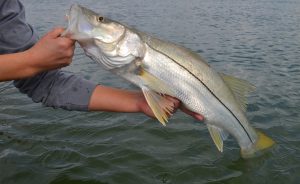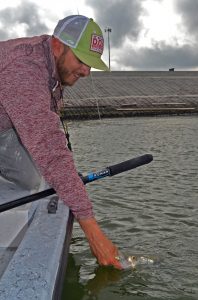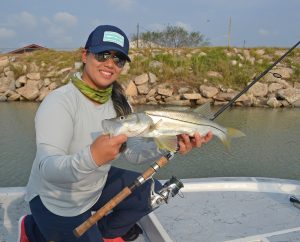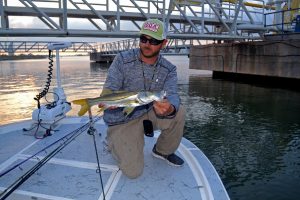
Mike Bosse with a big trout caught on a Down South Lure in red shad.
Interview by Brandon Rowan
Where are you from?
I was born is Cypress, Texas. We moved to Chappell Hill when I was four years old. I grew up there and went to Brenham High School. We grew up fishing ponds, the New Year’s Creek and the Brazos River. Eventually, we graduated to fishing Lake Conroe, Fayette, and Gibbons Creek before I got bit by the “saltwater bug.”

Down South Lure in Kickin’ Chicken.
Tell me about the journey that led up to the design and success of Down South Lures.
Like many people, I had an extreme love for fishing. Since I pond hopped all the time, I loved to fish for bass. This inspired me to make my first lure when I was 12 years old. I cut about 3 inches off my mom’s wooden broom handle and carved a cup out of one end to make a “popper lure.” Then I grabbed an old Heddon Torpedo, took the screw-in eyelet off the nose and screwed it into the nose of my bait. The hooks were removed from the old Torpedo, and I screwed those into the bottom of my lure. I did not paint the plug; I just tied it on and went fishing. A two-pound bass was caught that afternoon on it.
Since we bass fished big lakes like Conroe, we threw a lot of Carolina rigged sickle tailed baits in deep water. We loved the way the bait swam down off the ledges when we dragged them over humps and creek beds. We were firm believers that fish ate the bait when it was falling, more often than not. Well, fast forward about 15 years and I found a love for saltwater fishing. I noticed that most of the paddle tails and tout tails did not swim on the fall like our bass worms did. After that, I began to tinker with other plastic baits, modifying them to have action while falling. It just grew from there. More and more friends were asking me to make them baits. After that I cut my own mold design. It has grown into the Down South Lure that you see today.
Were there any unforeseen challenges or surprises have you encountered while developing Down South?
One of the biggest challenges in the lure industry is that you have to prove that your bait is different and has a place in peoples’ tackle boxes. The only way you can do that is by fishing with it, and getting it into the hands of reputable fishermen. Once they see that the bait has merit, they will begin to purchase your lure. It’s very hard to get fisherman to switch from something they have been throwing successfully for years.
Another surprise to me was that it was extremely hard to get shelf space. Going into it, I figured that if I had a good product with professional packaging, I would be granted pegs. That’s not the case at all. People have to ask for your products over and over. Then you can get a spot on the wall in a tackle shop.

Michael Naymik with a 23.3″ Galveston flounder caught on Down South Lures.
What is your personal favorite DSL lure/rigging?
I’m pretty simple. I like a 1/4 oz. or 1/8 oz. 3/0 jighead rigged with either the original Southern Shad or the Super Model XL. I throw various colors, depending on the water clarity. If I had to pick one color for all clarity it would be Chicken of the C.
What colors and riggings are best for the super DSL for big trout in the winter?
I like to go with as light a jighead as possible considering the conditions. If it is windy, or the current is moving pretty good you may have to use a little heavier jighead. If you notice that your lure is not getting down to the bottom, and there is a big bow in your slack line, you need to go heavier. My personal favorite “big fish” colors are Red Shad, True Plum, Key Lime, and Howell’s Strawberry Wine.
What kind of retrieve do you recommend when fishing DSLs?
Retrieves can vary with the conditions as well. My personal all-around favorite is to let the bait sink to the bottom and then retrieve with a twitch, twitch, pause cadence. I think fish are more reactionary feeders, and that they do not over think when feeding. That’s how they have survived this long. The twitch, twitch, pause resembles a classic “two hop” shrimp escape. Though my bait more resembles a fish swimming, or an eel escaping to the bottom, I always think that the most natural movements get the most strikes. You will notice that most of your bites will be when this bait is falling.
Do you have a favorite fishing moment? Could be a big fish or trophy but also a special fish or situation.
I have a bunch that stick out, but probably my favorite was when I was when I located some big trout while prefishing for a redfish tournament in Galveston. I was throwing my baits against a stretch of rocky shoreline. There was a lot of bait activity on that particular rock line point, so I fired my Chicken of the C in there and caught a 5 pounder. The next cast was another solid 5 pounder. I just eased away and told myself, “I’m bringing my girlfriend here first thing in the morning.”
We got up early, and I told her I was not going to fish, just run the trolling motor. We eased up to the point and she caught 3 fish very quickly to 4 pounds on a pink MirrOlure She Dog (She loves topwater and the conditions were perfect for it.) As we approached to honey hole, I told her to cast right by that one larger rock that had a wash out behind it. She gave it a perfect cast, and within 6 twitches she had a major explosion. It ended up being her largest trout ever measuring 28.5 inches. She said, let’s quit on that cast, but I wanted a flounder for lunch. We agreed to try for 15 minutes pitching around some rocks in a spot where I have caught them before. It was only 50 yards away from the trout spot. Within 5 minutes I had the solid thump of a flounder right by the boat on my Chicken of the C lure. I set the hook, and all hell broke loose. It was a big red! I told my girlfriend to get the net because I saw how many spots it had on its side. It was absolutely covered. I told her whatever you do, do not miss this fish! I’ll never hook one like this again. She got it on the first swipe. It measured 31.5 inches and had 144 spots on it. I took close up photos of both sides of the fish, and released the beauty for someone else to catch. We never made another cast that morning. I racked the trolling motor up and we headed back to the dock. The moral of the story is, I’ve had better days with numbers of fish, but we both broke personal records that day.

This big trout was caught on a Key Lime Super Model in Mansfield with Capt. Daniel Land.
What’s your favorite place you have fished?
If I had to pick one bay system in Texas, it would be Port Mansfield. The vast grass flats are just too appealing. The deep reefs and rocks of Galveston are a close second in the state. Poling for permit in the Florida Keys is my favorite out of state adventure.
Aside from fishing, what else are you passionate about?
When I’m not fishing, I like to hang out with friends, watch football, and BBQ while enjoying a cold beverage. We enjoy going deer hunting when we get a chance as well. Recently, I have become more intrigued with deer hunting, so my tournament partner and I have secured a deer lease in south Texas for next year.
Is there any Down South Lure news or upcoming events you’d like to let our readers know about?
Yes, always be on the lookout for new and innovating products and colors that we are working on releasing. Give us a follow on Facebook and Instagram to see all the updates. We post everything up there, and feature exceptional catches on our page. As always, we will have a booth at the Houston Boat Show in January, The All Valley Boat Show in McAllen in February, and The Houston Fishing Show in March. We always have our lures and apparel on special at these shows, so come by and get a deal. In addition, we will be doing some raffles and drawings for people that stop by at these shows. As always, you can shop all of our products at www.downsouthlures.com. See you guys soon and tight lines.







 By Capt. Brian “Flounder Professor” Spencer
By Capt. Brian “Flounder Professor” Spencer




























 Preparing Your Boat
Preparing Your Boat


